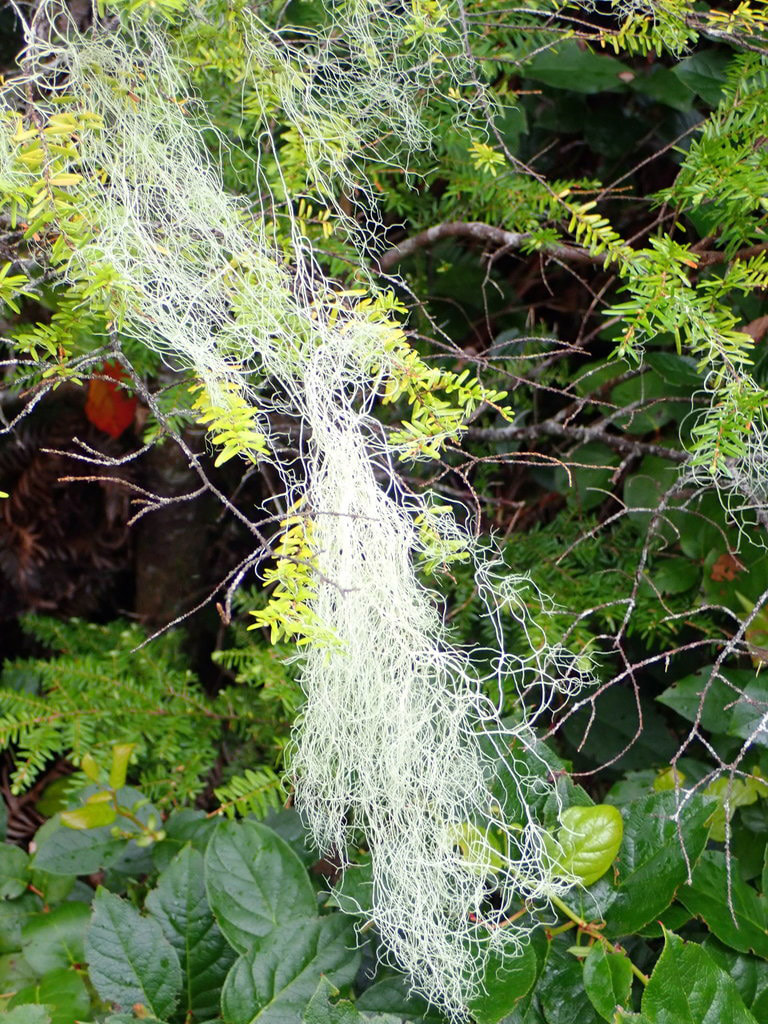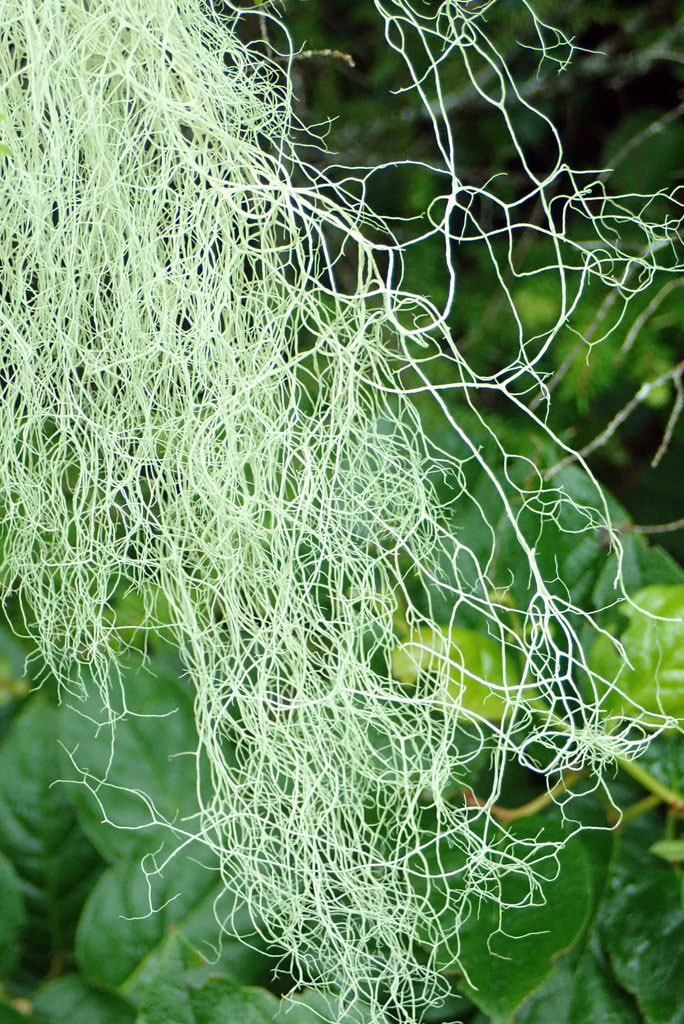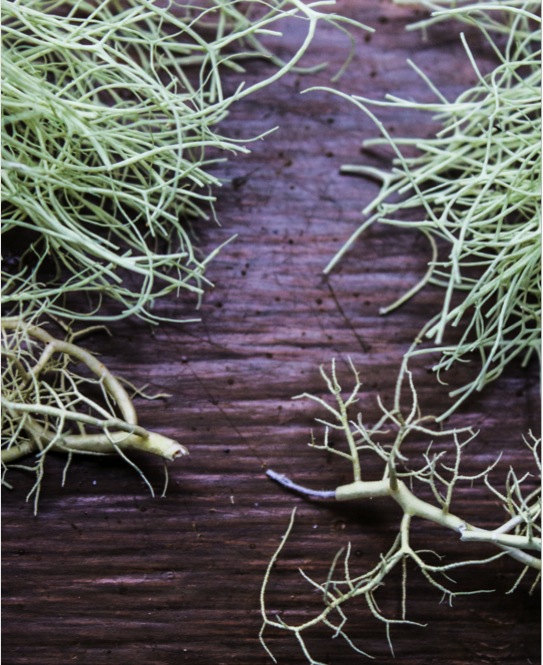Common witch's hair • Alectoria sarmentosa
• Heiltsuk/Haíɫzaqv - K̓ík̓váqvx̌ƛawa
Left and centre: photos by Andrew Simon. Right: a comparison of common witch's hair, behind, and Methuselah's beard, at front. While the two appear very similar superficially, the central cord of Methuselah's beard is revealed when cut whereas common witch's hair does not have this cord.
Identification
Common witch's hair is a 15-30 cm long hanging hair lichen. It is pale green and intricately branched, does not have a central strand, and does not have soredia (powdery microscopic clumps of algal and hyphal cells). Small brown saucer-shaped fruiting bodies (apothecia) often dot the branches.
Habitat & Range
This is a common species of lichen. It grows on and hangs off of coniferous trees in open forests. It is found at all elevations, but is most common from middle to upper elevations. Its coastal range in the Pacific Northwest stretches from Alaska to Oregon; it is found in locations throughout North and South America, as well as northern and Central Europe.
Similar Species
Methuselah's beard (Usnea longissima) is a similar hanging hair lichen with a central strand containing a central white cord. A comparison of the two species can be seen in the top right photo.
Vancouver witch's hair (Alectoria vancouverensis) is a similar, more greyish-green hanging hair lichen. It is only found at low elevations, whereas common witch's hair is more common at middle and upper elevations.
Human Uses
Alectoria fibres were used by the Nuxalk as false hair for decorating dance masks.
Intriguing Info
There are two common witch's hair subspecies: sarmentosa and vexillifera. Ssp. vexillifera is blue-listed in BC.
Deer browse on Alectoria species, particularly in old-growth forests in the winter when there is less available forage.
iNaturalist
https://www.inaturalist.org/taxa/126626-Alectoria-sarmentosa
Common witch's hair is a 15-30 cm long hanging hair lichen. It is pale green and intricately branched, does not have a central strand, and does not have soredia (powdery microscopic clumps of algal and hyphal cells). Small brown saucer-shaped fruiting bodies (apothecia) often dot the branches.
Habitat & Range
This is a common species of lichen. It grows on and hangs off of coniferous trees in open forests. It is found at all elevations, but is most common from middle to upper elevations. Its coastal range in the Pacific Northwest stretches from Alaska to Oregon; it is found in locations throughout North and South America, as well as northern and Central Europe.
Similar Species
Methuselah's beard (Usnea longissima) is a similar hanging hair lichen with a central strand containing a central white cord. A comparison of the two species can be seen in the top right photo.
Vancouver witch's hair (Alectoria vancouverensis) is a similar, more greyish-green hanging hair lichen. It is only found at low elevations, whereas common witch's hair is more common at middle and upper elevations.
Human Uses
Alectoria fibres were used by the Nuxalk as false hair for decorating dance masks.
Intriguing Info
There are two common witch's hair subspecies: sarmentosa and vexillifera. Ssp. vexillifera is blue-listed in BC.
Deer browse on Alectoria species, particularly in old-growth forests in the winter when there is less available forage.
iNaturalist
https://www.inaturalist.org/taxa/126626-Alectoria-sarmentosa
References
Alectoria sarmentosa (Ach.) Ach. In Klinkenberg, Brian. (Ed.). E-Flora BC: Electronic Atlas of the Plants of British Columbia. Lab for Advanced Spatial Analysis, Department of Geography, University of British Columbia, Vancouver. Accessed 15/09/2013.
Nash, T.H., Ryan, B.D., Gries, C., Bungartz, F., (eds.) (2001). Alectoria sarmentosa (Ach.) Ach. In Consortium of North American Lichen Herbaria. Accessed 25/02/2016.
Pojar, J. and MacKinnon, A. (1994). Plants of Coastal British Columbia. Vancouver, BC: Lone Pine Publishing. P. 504.
Authors and editors of page
Kelly Fretwell and Brian Starzomski (2013).
Alectoria sarmentosa (Ach.) Ach. In Klinkenberg, Brian. (Ed.). E-Flora BC: Electronic Atlas of the Plants of British Columbia. Lab for Advanced Spatial Analysis, Department of Geography, University of British Columbia, Vancouver. Accessed 15/09/2013.
Nash, T.H., Ryan, B.D., Gries, C., Bungartz, F., (eds.) (2001). Alectoria sarmentosa (Ach.) Ach. In Consortium of North American Lichen Herbaria. Accessed 25/02/2016.
Pojar, J. and MacKinnon, A. (1994). Plants of Coastal British Columbia. Vancouver, BC: Lone Pine Publishing. P. 504.
Authors and editors of page
Kelly Fretwell and Brian Starzomski (2013).







